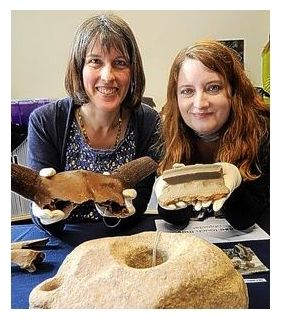
The historic investigation covers an area of land the equivalent of 262 football pitches at the site of the proposed Hinkley Point C nuclear reactor on the Somerset coast.
Surprisingly, given the geography involved, the remains of what looks to be an ancient harbour have been found nearly a mile inland.
Historians have been able to establish that the nuclear power station is situated on what used to be an isolated headland - until Roman times a large estuarine inlet filled the shallow valley to the south.
This provided a sheltered spot where ancient people, going back 4,000 years or even longer, could moor their primitive boats and fish.
These astonishing facts were revealed yesterday at an event staged at Somerset Museum where details of an archaeological excavation and education outreach programme funded by EDF Energy and carried out by Somerset County Council (SCC) were unveiled.
Not only have archaeologists discovered what looks to be the remains of an estuarine community, they have also uncovered the first ever Saxon style 'grub hut' to be found anywhere west of the River Parrett.
A number of Roman features and artefacts have also been found, including a grain drier, quern stones, a stone anchor, fishing net weights, jewellery and graves.
Steven Membery, SSC's senior historic environment officer, has been working on the site for five years. He said: "It is very unusual for archaeologists to be able to work on such a large piece of landscape - Hinkley C is the biggest infrastructure project in the whole of Europe and certainly the biggest archaeological survey I've ever been involved with.
"We think some of the remains signify a kind of port - a place where they were processing corn and then shipping it out. Hence corn dryers and quern stones.
"We believe that, from the Mesolithic period onwards, there was a flooded valley. After the Romans it silted up. Hinkley Point was a headland with a settlement on the shore side - it was highly protected - an ideal place for boats to moor up.
"The piles of stones we've found may well have been associated with a quay or something like that."
The project forms part of EDF Energy's site preparation works for Hinkley Point C. The heritage team is now undertaking an outreach programme across Somerset, giving residents an opportunity to find out about the history of the Hinkley Point site.



Reader Comments
to our Newsletter